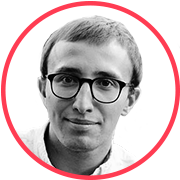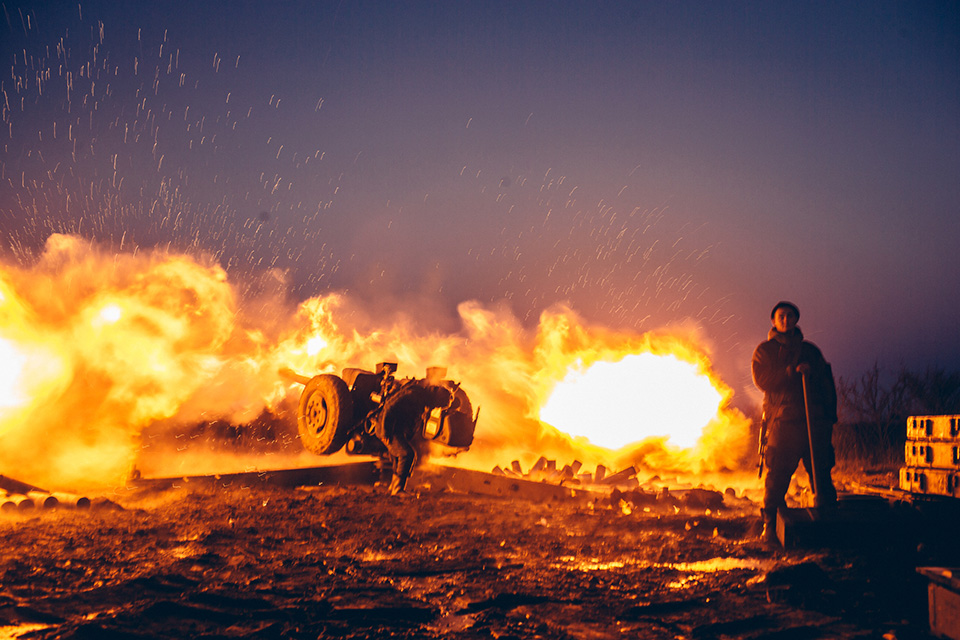On February 17th, BuzzFeed News published a photo story by Maxim Avdeev from Logvinovo village in Debaltsevo, Easten Ukraine; the area is currently a zone of military action. Bird in Flight talked to Avdeev about the ethical problems of shooting a military conflict, the inflation of horror, working during shelling and the situation on the frontline.

Why do you take graphic pictures?
When I talk to civilians in Europe about the war in the Ukraine, they usually say, “Well, yes, I’ve heard there is some kind of dispute, but we have a similar problem here with the Basques.” Everyone knows there is a confrontation, that soldiers are stationed there, but few people realize it is a real war with trenches and lice and people dying every minute.
{ “img”: “/wp-content/uploads/2014/07/warning-eng.jpg”, “alt”: “Maxim Avdeev for Buzzfeed”, “text”: “” },
{ “img”: “/wp-content/uploads/2015/02/avdeev_01.jpg”, “alt”: “Maxim Avdeev for Buzzfeed”, “text”: “” }
Photographers always have noble ideas and explanations of what kind of information they want to release, and to whom. But how do graphic images change anything?
I have no illusion that after I show my photographs that the war will take a different course or stop altogether. But people have a right to know what they have agreed to and what they are going to fight against. It is important to capture the war the way it is, to tell the truth. This is nearly World War II, but with more “grad” missiles.
Did you have ethical doubts — to take a picture or not take a picture — to have it published or not?
I have to deal with limitations from both sides of the conflict. If you think that those limitations are not acceptable, you just don’t work there. When someone asks me not to take a picture, I don’t, I respect that request. I don’t want to photograph dead bodies of soldiers. For me it is not acceptable either. But those are realities of war. Yes, I need to show losses, but I can do it in a discrete way, without close-ups, without blood and as correctly as possible, without showing faces.
In social networks there have been comments on whether it is ethical to show photos of dead people whose relatives probably don’t even know they were fighting in Debaltsevo.
There’s not a single image where you can recognise a person. I tried to shoot as to avoid close-ups of disfigured faces. I believe it is painful to see what has happened to one’s loved ones. I have a rule: if there is a dead person in the picture, relatives should not find out about his death from the media. And I always follow that rule, I haven’t broken it in these photographs.
{ “img”: “/wp-content/uploads/2015/02/avdeev_07.jpg”, “alt”: “Maxim Avdeev for Buzzfeed”, “text”: “” }
A lot of people say that because of the oversaturation of violence in the media the effect of crude shots is not so strong any more.
In fact, this is inflation of horror. Now there is so much visual violence in culture. But the contribution of news photography to it is not that big. The horrors of war have been documented many times since the Civil war in Spain, WW II, and the war in Vietnam.
Why did you work on the side of the DPR?
I worked on both sides. On the side of the Armed Forces of Ukraine (AFU), then for nearly two weeks on the side of Donetsk together with a French journalist. It is easier to get a pass to places of military action from DPR. It is much more difficult to deal with the AFU because the military doesn’t like journalists. And it is not because of my Russian passport. Only once did I manage to get to the position of the Ukranian artillery – accidentally – after waiting a few hours. It was impossible to get there even with the accreditation of the Security Service of Ukraine (SSU), with a press pass, with constant calls to the press secretary of anti-terrorist operation, photo checkups and waiting. DPR was not very easy either – we had to to knock our heads against the wall for three days to get lucky.
How did you make up your mind to spend so much time on the frontline, under constant shelling?
We spent around a week 1.5 km away from Debaltsevo. Until the ceasefire we would spend the day there and return to Donetsk and Artyomovsk for the night. After February 15 we didn’t leave Logvinovo for three days. There is no more road connection to Artyomovsk so I couldn’t figure out how to get there. The situation was drastic: a month without electricity, running water, normal food supplies. And all that in winter. People made outdoor fires to cook food and melted snow to make tea.
I try to avoid active military action because under shelling and during combat it is impossible to take any pictures. It’s only possible to die. Even when you are very close to action you tend to look for quiet moments, and they are always there – in the morning or towards the evening. There are quieter days when arrangements are made to evacuate the wounded. And for the night you try to get farther away – somewhere beyond the active shelling zone.
{ “img”: “/wp-content/uploads/2015/02/avdeev_03.jpg”, “alt”: “Maxim Avdeev for Buzzfeed”, “text”: “” }
What were your main difficulties?
Both sides of the conflict are extremely angry with one another. Their understanding of a journalist’s work is very conventional and they can take it badly if you don’t completely agree with them. For you are either their friend or foe. Questions like, “What do you think of the situation? What do you think of this war? On what side are you?” came up constantly. In their understanding you can’t be merely an observer. So it is a huge effort – to explain that you are not an enemy and that you are not going to pass on their positions and coordinates.
So how do you respond to those questions?
I am against the war. I am a photographer, and I work here. Sometimes negotiations can last for up to four hours before I manage to explain that I am not an enemy to either side. A few times they wanted to see the footage on my camera. And everyone understands that you also have an accreditation from the other side, but you are hiding it carefully and god forbid they find while you are still there.
{ “img”: “/wp-content/uploads/2015/02/avdeev_02.jpg”, “alt”: “Maxim Avdeev for Buzzfeed”, “text”: “” }
You have talked to the DPR. What are they fighting for now?
There are a lot of different people there now, so it’s complicated. Someone is fighting for his home. There are local people, a lot of local people – it’s not just Russians fighting there. There are Russian volunteers who had been watching TV, saw some manipulative stories, believed them – that it is virtual hell here – and decided to help. Their motivation is noble, but, one the other hand, they saw stories about crucified boys hanged on posts, about the Odessa events last May – highly emotional stories, and they believed every word of them. Also, there are a lot of people who consider themselves Cossacks and they are fighting for their “native territory.” Some others joke, “What’s the point of running around with a camera? Better take a gun: at least, we are better paid.” There are also “war junkies” who enjoy the war and flighting is all they are good at.
Is there any motivation for peace?
I’m not so sure. Judging by the conversations I’ve heard, few people want the kind of peace that was drafted in the Minsk agreements. Out in the field no one believed for a second that there would be no fighting on Sunday. It was obvious for everybody that on Sunday things would be just the same as on Friday, Saturday and Monday of the week before. Formally, yes, the canons stopped firing at midnight, but 12 hours later they resumed shelling.
Many soldiers on both sides are motivated to go till the end, but at the same time they say they are glad for the ceasefire because it means no more bombing of towns and no more casualties among civilians. It is their only argument for ceasefire.
Where does DPR get their resources from?
It is the help of the Russian government. No one denies that. Ukranian media say that the Humanitarian convoy brings arms to the rebels. But it doesn’t. Because the Humanitarian convoy is only 100 trucks a week. For just one day of fighting in Debaltsevo the soldiers need 20 tons of food. A single ‘grad’ unit requires two KamAZ trucks of ammunition daily. It is a real war, with a complicated management. It is easy to find 500 volunteers, supply them with body armour and machine guns. But it is a more difficult task to organize their life. Experienced people are needed for that. There is so much heavy machinery that needs a huge amount of diesel. It goes without saying that all that diesel needs to be regularly supplied. That’s why they needed Ilovaysk and Debaltsevo because those are railway connections. Russian support is apparent. But if it hadn’t been for an internal conflict within the country – it wouldn’t have been impossible to get the war wheel rolling. You can’t start a war in Belgium by sending 100 paratroopers there. Russian propaganda and people like Strelkov have acted like a fired match, but the gasoline had already been spilt.
{ “img”: “/wp-content/uploads/2015/02/avdeev_05.jpg”, “alt”: “Maxim Avdeev for Buzzfeed”, “text”: “” }
What does it feel like – to return from a battlefield?
The image change is radical. After we spent three days in Debaltsevo and returned to a Ramada hotel in Donetsk there it was: fruit for breakfast, clean bed linen, shower, Wi-Fi. And just two hours away from a world where a miserable dried food ration is all one could count on. That contrast was dramatic. My camera helps me a lot. It works like a psychological shield.
Are there ways to avoid propaganda?
It is impossible to fight propaganda – seriously, the’s no way. If a photograph has been published and someone wants to steal it and post their own caption underneath it there’s no way to prevent that. The Telegraph, Der Spiegel, Le Monde or Russian-language Meduza will never steal photographs and add the wrong captions to them. Media exist that are trustworthy. On the other hand, Ukranian Pravda, TASS and Sputnik I Pogrom are much more popular and have many more subscribers than the neutral Meduza. My photographs will not appear on RIA, Novosti or TASS, I don’t want them to appear in biased media. The only way of protecting an image from unauthorised use is not to post it and only show it to friends in a cafe on one’s phone.





